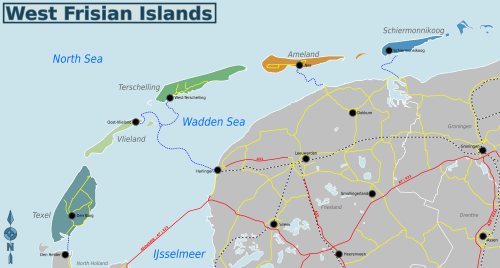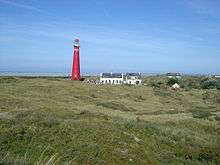West Frisian Islands
The West Frisian Islands (Dutch: Waddeneilanden) are a chain of islands that lie at the northern side of the Netherlands. The islands separate the North Sea from the shallow Wadden Sea, with tidal mud flats. The uninhabited islands Griend, Rottumerplaat, and Rottumeroog are nature reserves, access requires a permit. Wieringen used to be an island, but has been connected to the mainland, since the reclamation of the Wieringermeerpolder in the 1930s. The islands are part of the transnational Wadden Sea UNESCO World Heritage site.
Islands

| Texel (Den Burg) Largest of the Waddeneiland, housing 13,000 inhabitants. |
| Vlieland (Oost-Vlieland) Second-least densely populated of the island, which has completely banned cars. |
| Terschelling (West-Terschelling, Midsland) Third inhabited island in the Wadden Sea, being famous for events such as Oerol, as well as its production of cranberry-related products. |
| Ameland (Nes, Hollum) Fourth of the island and the third densest populated of the island, consisting mostly of sand dunes. |
| Schiermonnikoog (Schiermonnikoog) 16 kilometres (9.9 mi) long island that is mostly covered by the national park bearing the same name. |
Understand
The archipelago of the Frisian Islands, of which these Dutch islands are part, stretches all the way to the west of Denmark. They protect the Wadden Sea mudflats from the North Sea, making them key in the preservation of the natural areas around them. Most of the islands are already protected, and joint preservation efforts of the Netherlands, Germany and Denmark are working towards the establishment of a cross-border wildlife reserve. There are populations of earless seals and the mudflats that regularly fall dry at low tide, form an important foraging ground for many protected species of birds. However, the area holds both oil and natural gas, which bring major economic arguments in play and causing regular public and political discussions.
Today, some 25,000 people permanently live on the West Frisian Islands, or rather the Dutch part or the archipelago, most (around 13,500) on Texel.
Talk
The official language is Dutch and due to tourism, both English and German are fairly widely spoken. Frisian is an official language for the whole province of Friesland, including its islands. Although hardly distinguishable for most foreigners, the islands have their own dialect varieties of Frisian. Their use is declining, but island dialects are nonetheless still quite common outside the major towns.
Get in
By car
The islands can be easily reached by car from Amsterdam.
- For Texel take the highway up north to Den Helder and take the (car) ferry to Texel.
- For Vlieland and Terschelling, same way up north and cross the 'Afsluitdijk' (that separates the Wadden Sea from the IJsselmeer). Then follow the signs 'Harlingen' and 'Ferry'. Note: you can't take your car to Vlieland.
- For Ameland, follow the signs 'Leeuwarden' and from there 'Holwerd' and the ferry signs.
- For Schiermonnikoog from 'Leeuwarden' follow the signs 'Dokkum' and from there 'Lauwersoog' and look for the ferry sign. Note: you can't take your car to Schiermonnikoog.
By public transport
The ferries to the islands can be reached by train and bus.
- For Texel, take the train to Den Helder, then take city bus 33 or walk (about 25 minutes) to the ferry.
- For Vlieland and Terschelling, take the train to Leeuwarden and then the train to Harlingen Haven, which is right next to the ferry.
- For Ameland, take the train to Leeuwarden, then take the bus to Holwerd, where the ferry departs.
- For Schiermonnikoog, take the train to either Leeuwarden or Groningen, then from either city take the bus to Lauwersoog.
Island hopping
Another possibility to visit more Wadden Islands in a short period of time is island hopping on the Dutch Frisian Islands. In a week time you visit at least four out of five islands in an 8-days sailing/cycling trip by authentic sailing ship. Check out: wadfietsen.nl (fietsen is Dutch for cycling).
See

Most people come here to enjoy the rural and sea vistas and the relaxed atmosphere. Still, there are some museums, windmills and light towers to see, and the country-side is dotted with historic farms. A few highlights are listed below, see the individual island articles for additional information.
- The Ecomare natural museum in Koog, Texel doubles as a visitors centre for the Texel Dunes National Park, and houses a seal rescue centre and an aquarium. It's a great daytrip for both adults and children with many activities in high season. There are organized trips into the dunes, seal feeding presentations and lots of expositions to see. The island of Ameland has its own nature museum, the Natuurcentrum Ameland. It's much smaller but has a sea aquarium as well and lots of information about the islands, their nature and sustainment efforts.
- Several of the islands have lighthouses, typically dating back to the 19th century. The Eierland Lighthouse on Texel is of particular interest, as it is open for visitors up to the 6th story. The square shaped Brandaris tower on Terschelling is the oldest lighthouse in the country, built in 1594.
- The island countryside is dotted with charming villages and monumental farms. The many buildings that have a protected monumental status (Terschelling alone has 111 listed properties, are of a picturesque, rural kind. There are no massive town halls or cathedrals, but rather centuries old village houses, parish churches and chapels and many old farms.
Do
The West Frisian Islands are an excellent place to relax, stay at a camping or small cottage, and enjoy the beautiful nature. Popular activities include cycling across the island, spending some time at the beaches, birdwatching in one of the natural reserves and horseriding.
- Oerol Festival. In June, the island of Terschelling hosts one of the largest theatre festivals in Europe. The Oerol theatre festival is a cultural happening full of play, music and arts. Some 50.000 visitors come to the island to join the event each year. Stages are set up all over the island: in the dunes, in barns, on the dikes and in the villages, creating a delightful, bustling atmosphere all around. €20.
Eat
Tourism is a major source of income on all of the inhabited islands, and there are plenty of establishments that cater to visitors, varying from simple bakeries to exclusive restaurants. There are places to eat in every of the larger villages, with most choice in the main towns like Nes on Ameland, West-Terschelling on Terschelling or De Koog on Texel. Many of them will serve regional specialities, making use of high quality local produce like mutton, sheep cheese, oysters, local shrimp, cranberries and in Spring, white asparagus.
Texel is in many ways the culinary highlight of the Dutch Wadden islands. It has a Michelin starred restaurant with a focus on regional products an annual culinary festival, and the tourist office even sells a bike route (€1) for self-caterers, with a Wadden island menu and a list of local producers from where you can buy the ingredients.
Drink
There's a surprising number of bars and cafés around, considering the fairly rural nature of the region. Outdoor terraces pop up everywhere when the weather allows, making great and relaxing places to kick back with a drink. Again, this is a direct result of the flocks of tourists that make their way here, among which are good numbers of youngsters. For dancing, De Koog on Texel is a good pick, with a club and some beach pavilions.
In terms of local drinks, Texel's own beer brewery in Oudeschild produces its own selection of beers, which you'll find at most cafés or can try at the brewery's tasting room. And then, there Syltsje, a distilled drink of Terschelling, commonly served on the other islands as well.
Stay safe
As long as you stay clear of the water, there's little danger around. Of course, don't go mudflat walking without a qualified guide and use you common sense when engaging in any water sports or other outdoor activities.
Go next
For most regular travellers, the next step will be to head back to mainland, either to explore the rest of the Northern Netherlands, or the Western Netherlands. Franeker, Leeuwarden and Groningen are worthwhile destinations in the north, not too far from the coast. If you catch the boat to Den Helder, the cities of Enkhuizen and Alkmaar make fine nearby stops, with Haarlem and Amsterdam just a little bit further off.